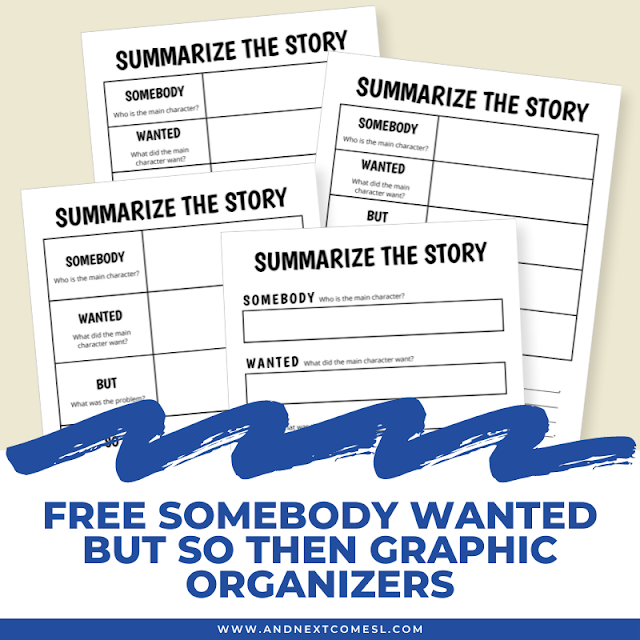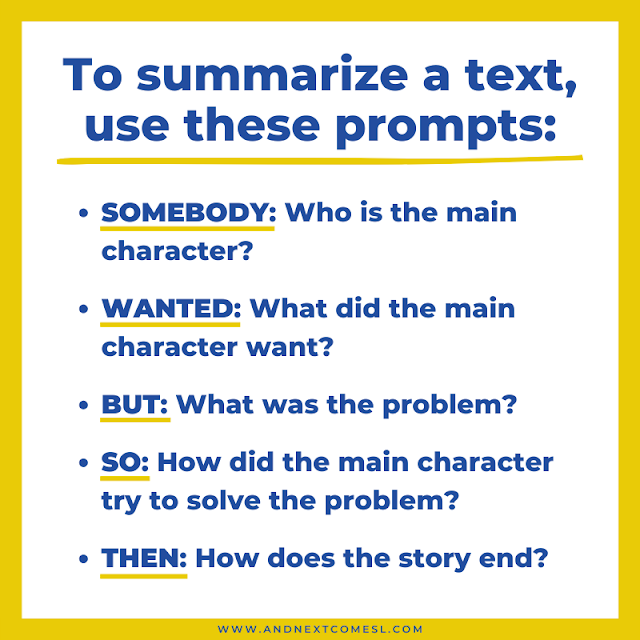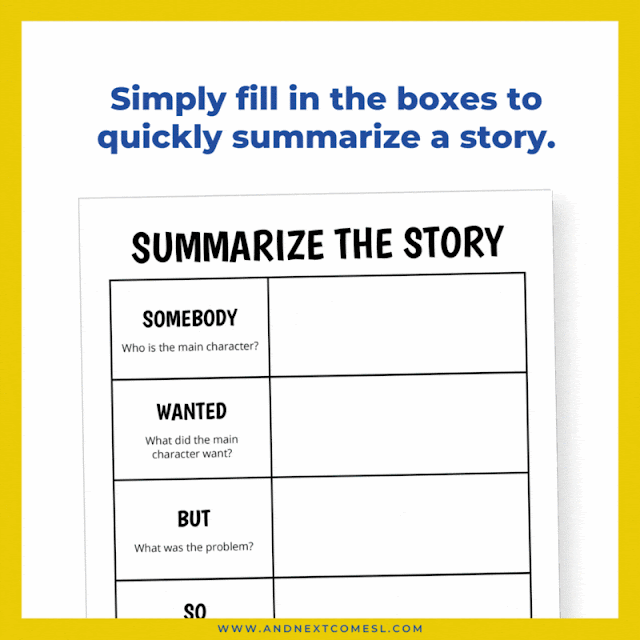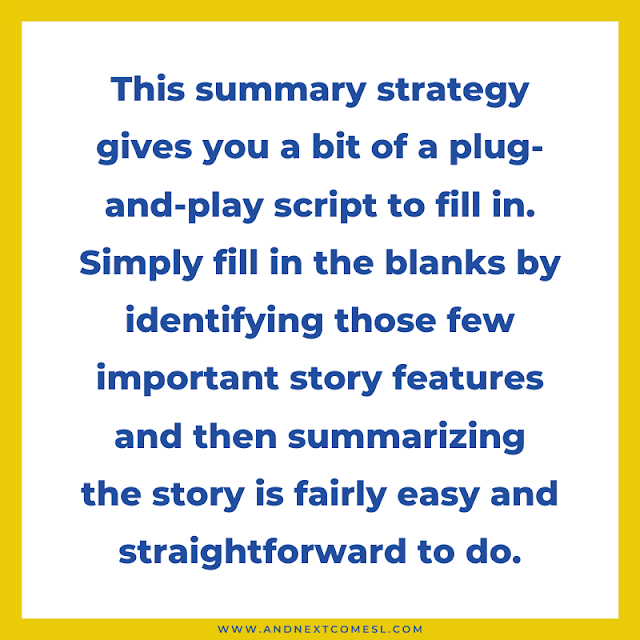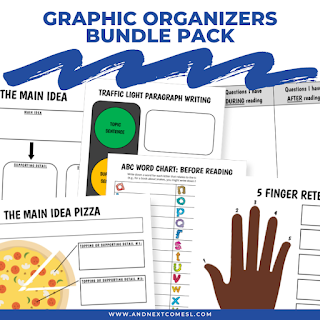It's no secret that hyperlexic kids need some extra support with comprehension. Especially as they enter the middle school years. Grade four in particular is a big challenge because task demands increase and reading for meaning becomes the priority. There's a shift to more novels and chapter books and having more background knowledge. That kind of thing.
So often our hyperlexic kids might need a bit of extra help with making inferences, summarizing a story, identifying the main idea, synthesizing important information, and so on...
One invaluable tool, though, for helping hyperlexic kids (not just with comprehension!) is to use visual supports, such as graphic organizers (see tip #1 here).
We've been using graphic organizers with my son for a number of years with great success. We use them for writing, comprehension, brainstorming, organizing information, and a variety of other things. They have been a complete game-changer for my son.
For instance, we use these somebody wanted but so then graphic organizers to help with summarizing a text or story. It breaks everything down into 5 simple parts and can be used with a variety of texts.
Below you'll learn more about this particular comprehension strategy and see an example of how to use it. Then you can grab these graphic organizers and give them a try yourself. They're great for at home or school. So let's dig in!
About the Somebody Wanted But So Then Strategy (SWBST)
Somebody Wanted But So Then (or SWBST for short) refers to a summarizing strategy that can be used to check a student or child's comprehension. It is often used after reading a story, but you could probably use it during reading as well.
Basically, you summarize a story using the following set of prompts (the same prompts that make up the name of this strategy). They are:
- SOMEBODY: Who is the main character?
- WANTED: What did the main character want?
- BUT: What was the problem?
- SO: How did the main character try to solve the problem?
- THEN: How does the story end?
You can see where this reading comprehension strategy gets its name from, right?
Anyway, what's great about this technique is that it helps kids break down the story into its different parts or story elements. They have to think about who the main character is, what the main idea of the story is, recognize cause and effect, and more. It's an important skill students need when it comes to summarizing.
Summarizing a story or novel is less daunting when you can break it down into smaller parts like this. Something that many hyperlexic kids find helpful. Then, once it's all broken down, you can easily give a brief summary of the plot or entire text in just a simple sentence or two.
Somebody Wanted But So Then Examples: Let's See this Key Comprehension Strategy in Action!
Now that you know what the strategy is, let's apply it to a familiar text or popular fiction story, such as the classic fairy tale of Little Red Riding Hood. That way you can see how this summarizing strategy is used.
You'll quickly see how we can form a simple sentence summary when we use this technique. For instance, here's how we would break down this particular story:
- SOMEBODY: Little Red Riding Hood
- WANTED: To bring some treats to her grandma who was sick
- BUT: The wolf got to grandma's house first
- SO: The wolf pretended to be grandma
- THEN: (1) The wolf eats both the girl and her grandma. (2) A woodsman/axeman saves the girl and her grandma. or (3) The girl runs away. There may be some other variation depending on which version you're reading.
Now that you've answered all the prompts above, you can easily write a plot summary. For this fairy tale that might look like...
Little Red Riding Hood wanted to bring some treats to her grandma who was sick, but a wolf got to grandma's house first and pretended to be Little Red Riding Hood's grandma. Then just when the wolf was going to eat Little Red Riding Hood and her grandma, a woodsman saves the day. Yay!
Did you notice how this summary strategy gives you a bit of a plug-and-play script for kids to fill in? All they have to do is fill in the blanks by identifying those few important story features. Then summarizing the story is fairly easy and straightforward to do.
Now that you have a better idea of how this strategy works, let's talk about the free graphic organizers.
About the Somebody Wanted But So Then Graphic Organizers
Below you will find multiple variations of the somebody wanted but so then graphic organizers. Some are digital and perfect for Google Classroom. Others are printable and can be used at home or in the classroom. Some include lines to write a summary sentence after you've filled in all of the boxes and others do not.
If you're going to print off one of the graphic organizers, you might want to consider laminating it. That way you can reuse it as much as you want or need. Plus, it will save you some precious planning time because you can wipe it clean and save it for the next time it's needed. By the way, here's the laminator that I use and love.
Laminated or not, to use any of the graphic organizers, simply fill in the boxes with the appropriate information. For instance, in the somebody box, you'll identify who the main character is and write their name down. Then you'll think about what it is the character wanted and write it down in the wanted box. And so on.
Once you've filled in the boxes on the corresponding graphic organizer, you'll be able to summarize the story. You might summarize it into one big long sentence (if the story is shorter) or into one short paragraph (if the story is longer). Regardless, it makes summary writing a breeze because you've already identified all the important story features.
For the digital graphic organizer versions, text boxes are already inserted into the document. So you simply click one of the boxes and start typing. Easy, peasy!
Download the Free Graphic Organizers
Looking for More Graphic Organizers?
You'll find even more graphic organizers for reading and writing in the graphic organizers bundle pack.
Click here to get your copy of the graphic organizers bundle pack


